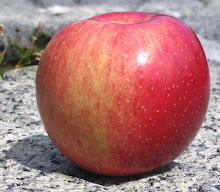Turn your apple over and you will see a small star-shaped mark or opening. That's the calyx, from the Greek kalyx via Latin. It tells a story.
Your apple was once a flower. An apple blossom fluttering in the perfumed breeze, her petals wide to all comers.

|
Or maybe I should say his petals, because this baby has a stamen, too, about 20 of them.
In the only pretty little ring time a bee comes and does his thing, or maybe it's another bug or even a botanist. Hey ding a ding a ding.
The petals whither and fall away, pink scented snow. Five green sepals remain.
The ovary swells and the sepals contract into a little bee-stung mouth that still holds the whithered stamens.
The calyx comprises the sepals, and the term applies to the blossom stage too.With the help of the sun and the rain (and, frequently, the farmer) this fruit grows through several phases into a ripe apple, hanging heavily down now by its stem.
The mouth closes entirely, or nearly so.

|
If it's open, or if you cut the apple lengthwise, you can usually see the dried up stamens if you look closely.
This whole marvelous process is charmingly documented in a photo essay by the Botanical Society of America, reviewed here.
Calyx is an elegant word, lovely in the mouth and on the page. It is related to chalice, another bon mot. I like to use it, perhaps too much, as I've gotten the habit of describing the calyx when I review an apple.
Is this really useful or interesting? Maybe from a taxonomical perspective, but that's not what I aim for. So I'll try to throttle back on the calyx a little. But every apple has one.
The above photo of the apple blossom, by Roger Griffith, is in the public domain. The entire lovely image (and its license) is here.

I enjoyed reading about this. I've noticed you using the word 'calyx'. I was thinking it sounded Greek because it reminds me of the word 'pyxis', mostly because of that 'x' in there, I think. I've noticed you using several words, things like 'lenticel'. I looked that up and having found the definition I realized that those are the things I think of as freckles. I think it's a lovely thing that the apple retains and incorporates the former blossom, or part of it anyway, in the final fruit.
ReplyDeleteNina
Pyxis is the last entry in my dictionary before the Qs. (Yes, I had to look it up.) It is also, apparently, a southern-hemisphere constellation, the compass of the mythical Argo. Strange to think of classically trained European astronomers extending ancient Greek myths into the Southern skies.
ReplyDeleteI searched in vain, however, for any stellar apples. Apples are present in the old Greek tales of the universe, where they frequently are made of gold.
Hercules quested for them; Aphrodite gave three to Hippomenes (to win a race and the hand of Atalanta); Eris, the Goddess of Discord, used one to start the Trojan War.
This distinguished pedigree, however, is not sufficient to win apples a place in the heavens. Go figure.
Out of curiosity, is there a term for the bumpy "legs" surrounding the calyx on some cultivars? Is their presence related to the sepals?
ReplyDeleteI sometimes call them "chins." They are pretty clearly the expression of ribbing.
DeleteI am not aware of any formal term. As for the sepals, here is what I know: apples are generally pentagonally symmetrical, so there are 5 sepals, 5 ovary chambers, a five-pointed star if you slice one horizontally, etc. There are usually five of these calyx-end bumps if they are present.
So I think both sepals and legs are based on this symmetry, rather than one causing the other.